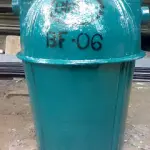
If you have just bought a house and discovered the water tank in the loft doesn’t have a lid, you may be wondering whether it should be covered.
The water tank in your loft should be covered with a lid to prevent dust, birds and vermin from entering the tank. Also, water in a water tank without a lid can evaporate into the loft space and may cause condensation. If you have a header tank for your heating system this should also have a lid.
If you’re not sure why you have a water tank (or perhaps two water tanks) in your loft, please read on. Do you know how to check which taps in your house are fed from your cold water tank in your loft? If you don’t, please read on, as I explain a simple way for you to work this out.
What is the water tank in the loft for?
The large water tank in your loft is used to supply water to the taps on your baths and sinks and to the cistern on your toilets, which are on a low-pressure system. The water tank also supplies water to your hot water cylinder, which then supplies hot water to the taps on your baths and sinks.
Many houses also have a second water tank in the loft, which is called a header tank. If you have a header tank, this is used as a feed and expansion tank for your heating system. This should also be covered with a lid to prevent dust and debris from entering your heating system.
How do you cover a water tank?
You should cover your water tank with a lid designed to fit the tank to create a secure seal. This will help prevent any dust, debris or vermin from entering the water tank. The outside of the tank should also be covered with insulation to prevent the water in the tank from freezing in the winter.
How to find a replacement cover for your water storage tank
If your cold water storage tank doesn’t have a lid, follow these steps to find a replacement:
- Look around the loft for the original lid. It would be unusual for the lid not to be in the loft, so check it’s not be taken off and put down in the roof space first.
- Check the side of the tank for a make and model. If you cannot find the tank lid inside your loft check for the make, model and size of the water tank on the side of the tank. Use this to search for a replacement lid.
- Measure the dimensions of the top of the tank. If you cannot find a make and model, or if the tank is no long in manufacture, you may be able to find a similar size lid instead to cover your water tank.
- Replace the cold water storage tank. If you cannot find a replacement lid for your cold water storage tank, you should have the tank replaced with a new tank and lid. It’s possible to DIY fit a new cold water storage tank, but you may be advised to use a qualified plumber instead. One of the challenges is getting the old tank out of your loft, but also getting a new on into the loft through the loft hatch too.
Can you drink water from a cold water storage tank?
It’s not recommended to drink the water from your storage tank as the water may contain bacteria. The water will sit in your water storage tank and impurities can get in, even if it has a lid. You are therefore best to only drink water from taps connected to the mains water supply.
How do you know if the water from a tap comes from your storage tank?
If you want to check if the water from a tap comes directly from your mains supply or from your water storage tank in the loft, turn the stop-cock off at the mains. The taps fed directly from the mains will no longer work, but all the taps fed from your colder water storage tank will continue to work until the water tank runs dry.
Other cold water tank recommendations
- Make sure the lid is securely sealed. The lid on your cold water storage tank should be securely sealed.
- There should be an air-gap between the surface of the water and the inlet pipe. The cold water storage tank should only fill to a level that is below the water inlet. If the water level exceeds the inlet pipe, impurities can enter the mains water supply. But also, if the tank starts to over-fill, there’s a greater risk it could over-flow.
- Check the ball-valve is closing off properly. Ball-valves can wear over time and can leak. A leaking ball-valve will mean your cold water storage tank could over-flow and damage your home.
- Flush-out your water tank. If you have been away from the house for more than a month it’s a good idea to flush-out your cold water storage tank.
Final thoughts on should a water tank in loft be covered
If you find your water tank doesn’t have a lid, before you replace the lid, make sure you check how clean the water is. If there is any dust or debris in the tank, you should clean this out first.
- First take out any large or obvious bits of debris from the tank.
- Try to skim-off any dust that’s sitting on the surface of the water.
- To fully clean your tank out you will need to drain it first. This can either be done by turning off the mains water, or by tying up the ball-cock to prevent more water entering the tank.
- Once the water inlet has been turned off or the ball-valve tied up, drain the water by turning the taps on to your bath and sinks, plus flush your toilets a few times. Make sure you only turn on taps connect to your cold water storage tank. Follow the advice above to check which ones these are.
- When the tank is empty of water, clean out the bottom of the tank.
- Turn the mains on and flush the system through with clean water by leaving your bath and sink taps running.
I hope you’ve enjoyed this article about should water tank in loft be covered
If you’ve enjoyed this article about “should water tank in loft be covered” please share it on your favourite social media site.
Also, if you have any questions, please feel free to comment below too. Alternatively, if you need more help, please feel free to contact us on our contact us page here. Or join the discussion and ask your question in the property forum.




